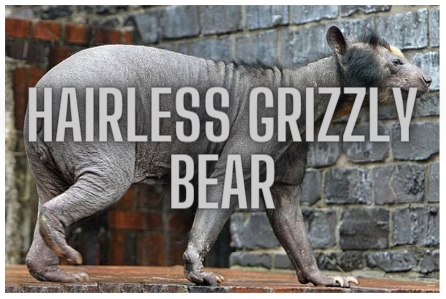In the vast realm of wildlife, nature occasionally presents us with extraordinary anomalies. One such rarity is the hairless grizzly bear—a creature that defies our expectations of what a grizzly bear should look like. In this article, we will explore the fascinating world of hairless grizzly bears, discussing their unique characteristics, potential causes of hair loss, their survival challenges, and the implications of their presence on conservation efforts.
Understanding Hair Loss in Grizzly Bears
Hair loss, or alopecia, in grizzly bears is an unusual occurrence. Grizzly bears (Ursus arctos horribilis) typically possess a dense coat of fur that provides insulation, protection, and helps them blend into their environment. However, hairless grizzly bears exhibit partial or complete alopecia, leaving them with exposed skin that can range from pinkish to grayish in color. Understanding the causes and implications of hair loss in grizzly bears is essential to appreciate the challenges they face.
Potential Causes of Hair Loss
The exact causes of hair loss in grizzly bears are not yet fully understood. Various factors may contribute to this phenomenon, including genetic mutations, hormonal imbalances, nutritional deficiencies, parasites, infections, or environmental stressors. It is important to note that hair loss in grizzly bears can occur naturally, without necessarily indicating a health issue.
Survival Challenges
Hairless grizzly bears face distinct challenges when it comes to survival. The loss of their protective fur leaves them more vulnerable to the elements, including extreme weather conditions. Without fur, they lack insulation and are more prone to hypothermia during colder months. They may also be susceptible to sunburn, skin infections, and injuries. Additionally, their exposed skin makes them more visible to predators and can hinder their ability to camouflage while hunting or seeking cover.
Adaptation and Behavioral Changes
Hairless grizzly bears may exhibit behavioral adaptations to cope with their unique circumstances. They might alter their activity patterns, seeking shelter in dens, forested areas, or other protective environments during harsh weather conditions. They may also modify their foraging strategies or adjust their behavior to avoid unnecessary risks. Understanding how hairless grizzly bears adapt can provide valuable insights into the resilience and flexibility of these remarkable creatures.
Conservation and Management
The presence of hairless grizzly bears underscores the importance of conservation efforts. Protecting these unique individuals contributes to biodiversity preservation and highlights the need for habitat conservation and wildlife management. Conservation organizations and wildlife agencies work towards ensuring the long-term survival of hairless grizzly bears by addressing threats to their habitats, minimizing human-wildlife conflicts, and promoting public awareness about their significance.
Educational Value
Hairless grizzly bears offer educational opportunities for researchers, conservationists, and the general public. Studying these rare individuals can deepen our understanding of the genetic variations within grizzly bear populations and shed light on potential environmental factors contributing to hair loss. The presence of hairless grizzly bears can also ignite conversations about the impacts of climate change, habitat degradation, and the overall health of wildlife populations.
Final Thoughts
Hairless grizzly bears display a unique and captivating aspect of the natural world. While the causes of hair loss in these bears remain a subject of study, their presence highlights the challenges they face in terms of survival and underscores the importance of conservation efforts. By understanding and protecting hairless grizzly bears, we contribute to the preservation of biodiversity and gain valuable insights into the resilience and adaptability of these remarkable creatures that inhabit our wild landscapes.

